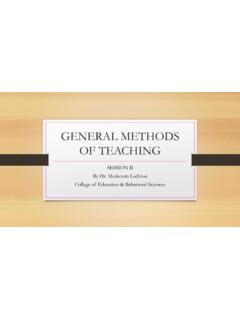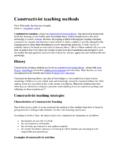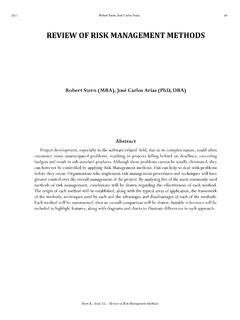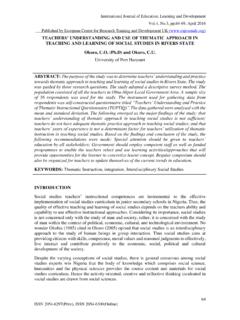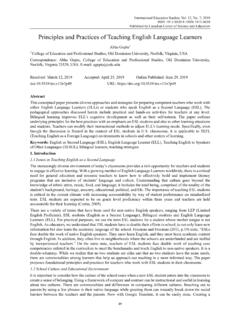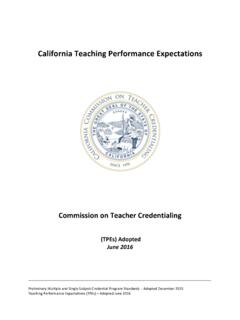Transcription of Approaches to Internationalisation Strategic Management ...
1 IMHEI nstitutional Management in Higher EducationApproaches to Internationalisation and Their Implications for Strategic Management and Institutional PracticeA Guide for Higher Education InstitutionsIMHEI nstitutional Management in Higher EducationFabrice H nardLeslie DiamondDeborah Approaches to Internationalisation and Their Implications for Strategic Management and Institutional Practice Fabrice H nard Leslie Diamond Deborah Roseveare 2012 2 This document and any map included herein are without prejudice to the status of or sovereignty over any territory, to the delimitation of international frontiers and boundaries and to the name of any territory, city or area.
2 You can copy, download or print OECD content for your own use, and you can include excerpts from OECD publications, databases and multimedia products in your own documents, presentations, blogs, websites and teaching materials, provided that suitable acknowledgement of OECD as source and copyright owner is given. All requests for public or commercial use and translation rights should be submitted to Requests for permission to photocopy portions of this material for public or commercial use shall be addressed directly to the Copyright Clearance Center (CCC) at or the Centre fran ais d exploitation du droit de copie (CFC) at 3 Foreword The OECD s Higher Education Programme (IMHE)
3 Launched a project in April 2011, entitled Managing Internationalisation , to explore the interwoven relationships between the Internationalisation strategies of governments and higher education institutions so as to help them face the range of challenges associated with Internationalisation . The project was based on existing research and built on the accumulated knowledge and experience of volunteer members of the OECD Higher Education Programme. A series of online focus groups were held over 2011 and 2012 to share perspectives across institutions, governments and international organisations. The findings of these focus groups were examined at two international conferences held at Lund University in December 2011 and at the State University of New York in April 2012.
4 In addition, the project took into account activities of other international associations, such as the European Association for International Education (EAIE), the Institute for International Education (IIE), the International Association of Universities (IAU), the Observatory of Borderless Education (OBE), and the World Bank. The project identified factors, instruments, Approaches and reference points that have an impact on, or are affected by, Internationalisation . Internationalisation is clearly here to stay and this report concludes with some pointers for what governments can do to promote and support Internationalisation and what higher education institutions can do to manage Internationalisation more effectively.
5 The authors of this report would like to thank the individuals, institutions and organisations that collaborated with the OECD Higher Education Programme (IMHE) on this project, and in particular wish to acknowledge the invaluable contributions of: Britta Baron, University of Alberta (Canada) Jeffrey Belnap, Zayed University (UAE) Kathryne Bindon, Takatuf-Oman Oil (Oman) Jocelyne Gacel- vila, University of Guadalajara (Mexico) John Hearn, University of Sydney (Australia) Rebecca Hughes, Sheffield University (UK) Kevin Kinser, State University of New York at Albany (USA) Kees Kouwenaar, Vrije University (The Netherlands) Jason Lane, State University of New York at Albany (USA) Robert Nachtmann, University of Texas El Paso (USA) Chris Nhlapo, Cape Peninsula University of Technology (South Africa) sa Petri, Ministry of Education and Research (Sweden)
6 Peter Plenge, Aalborg University (Denmark) Abdouli Touhami, Euro-Mediterranean University, Slovenia Marijke Wahlers, German Rectors Conference-HRK (Germany) John Zvereff, Universitat Oberta de Catalunya (Spain) We would also like to thank the academics who provided the examples included in this report and we offer special thanks to the Rector and staff of Lund University (Sweden) and to the Chancellor and staff of the State University of New York (USA) for co-hosting the project s two conferences. Finally, we would like to express our appreciation to our colleagues in the OECD s Directorate for Education who have contributed in different ways to this project.
7 4 5 Table of contents Foreword .. 3 Why focus on Internationalisation ? .. 7 Government policy and international strategies .. 10 Internationalisation and off-shore campuses .. 14 Internationalisation through dual and joint programmes .. 19 Internationalisation and international networks .. 22 Internationalisation and organisation of higher education institutions .. 25 ICT assisting institutions in Internationalisation .. 28 Internationalisation and ethics and values .. 32 Internationalisation and intellectual property .. 35 What governments can do to promote and support Internationalisation .. 37 What institutions can do to manage Internationalisation more effectively.
8 40 Bibliography .. 43 More about the OECD Higher Education Programme (IMHE) .. 47 6 7 Why focus on Internationalisation ? Internationalisation of higher education is not new. Many of the earliest scholars travelled widely in Europe, but in the early modern era the focus on national development and Internationalisation became marginalised. Nonetheless, initiatives such as the Fulbright Scholars Program in the United States and the Erasmus Mundus Programme in Europe have aimed to promote mutual understanding and encourage collaboration among higher education institutions. Today, however, the accelerating rate of globalisation has focussed attention once again on student mobility, international research collaboration and education as an export industry.
9 In today s age of global knowledge and technology, an interconnected network and global awareness are increasingly viewed as major and sought-after assets. With the current labour market requiring graduates to have international, foreign language and intercultural skills to be able to interact in a global setting, institutions are placing more importance on Internationalisation . The number of students enrolled in higher education outside their country of citizenship practically doubled from 2000 to 2010 (OECD, 2012a) and this trend is likely to continue. However, student mobility is simply the most visible part of a greater topic, namely Internationalisation , which is more complex and multifaceted.
10 One aspect, sometimes referred to as Internationalisation at home, consists of incorporating intercultural and international dimensions into the curriculum, teaching , research and extracurricular activities and hence helps students develop international and intercultural skills without ever leaving their country (OECD, 2004; W chter, 2003). Other fast-growing forms of Internationalisation are emerging ( transnational education sometimes delivered through off-shore campuses, joint programmes, distance learning, etc.) and suggest a more far-reaching approach, especially where higher education is now seen as an integral part of the global knowledge economy.










